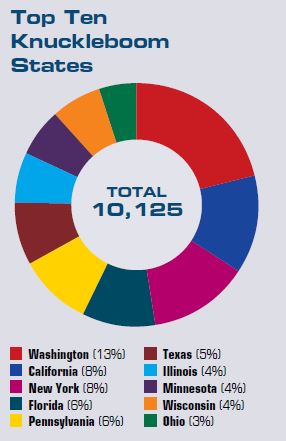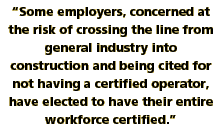March 2019—If NCCCO’s experience is anything to go by, there are going to be a lot more truck drivers carrying a CCO card on the nation’s highways in coming months—at least those equipped with articulating boom cranes (knucklebooms).
 According to data just released by NCCCO, demand for knuckleboom written and practical exam testing in 2018 was up by 28 percent compared with the previous year. This followed a massive 96 percent surge from 2016 to 2017.
According to data just released by NCCCO, demand for knuckleboom written and practical exam testing in 2018 was up by 28 percent compared with the previous year. This followed a massive 96 percent surge from 2016 to 2017.
When all three categories for which NCCCO offers a certification – with hook, with winch, and with fork attachment (loader) – are considered, knucklebooms with just a hook predictably account for the lion’s share of the testing conducted. However, those equipped with a winch made a surprisingly strong showing (22 percent), almost equal with articulating boom loaders (24 percent).
Regional differences are marked, said NCCCO Director of Operations, Joel Oliva. “Ten states account for more than 60 percent of all certified articulating crane operators (see sidebar),” he said. “Washington State leads the pack, accounting for fully 13 percent of all certificants since testing began in 2009.” It’s pretty clear that the combination of a local jurisdiction requirement, such as in Washington State or New York City, that was put in place ahead of the federal rule, along with effective enforcement, goes a long way to accounting for some of the variations.
Building Supplies Fuel Surge
But why the big surge over the last two years?
“Two words,” said NCCCO Program Manager, Tara Whittington, “Building supplies.” Indeed, it seems from reports by the top dozen or so training firms who account for the largest proportion of pre-CCO exam preparation that delivery of building materials to construction sites accounts for much of the sudden interest in certification ahead of the federal rule that went into effect in November.
“For some building supplies companies, certification wasn’t even on their radar and so with the November deadline looming they scrambled into action,” said Whittington. “For others, many thought they were exempt until OSHA made it clear that anything other than unloading materials at a jobsite and placing them on the ground would cross the line from general industry into construction and trigger the certification requirement.”

NCCCO’s Regulatory Affairs Coordinator, Matthew Shaw, agreed. “The minute an operator starts to arrange roof trusses or joists, for example, on the ground to facilitate hoisting by another crane, rather than merely place them there, he has to be certified.” The same is true for loader cranes used for delivering such items as drywall. “Invariably these items are not offloaded onto the ground but lifted to the desired floor level,” said Shaw. “At that moment these cranes fall completely under the construction regulations, and they have to be operated by a certified operator.” Some employers, concerned at the risk of crossing the line from general industry into construction and being cited for not having a certified operator, or baulking at having to track who is—and who is not—certified, have elected to have their entire workforce certified. “At $13,000 per citation, and ten times that for a repeat or willful violation, employers are choosing rather to invest in certifying their operators,” Shaw adds.
“Some employers, concerned at the risk of crossing the line from general industry into construction and being cited for not having a certified operator, have elected to have their entire workforce certified.”